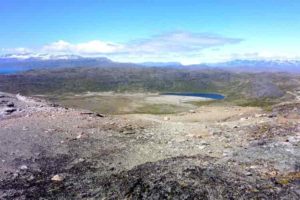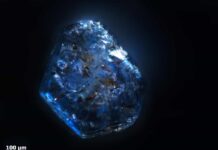
A new understanding of how volcanic processes form deposits of rare earth metals, vital to everyday modern technology, is revealed in a new study from the University of St Andrews.
The research, led by a team from the School of Earth and Environmental Sciences at St Andrews and published in the journal Geology (Friday 3 December), provides new clues about how hot volcanic fluids concentrate rare earth metals and how these metals seep out from the magma body.
These rare metals, which include elements such as niobium and tantalum, are essential for the production of alloys, batteries, magnets and superconductors, and are vital for modern technologies ranging from mobile phones and laptops to MRI machines. These metals are also essential for green technologies and, crucially, the transition to a low-carbon economy must involve finding new sources of the rare earth metals.
Rare earth deposits are associated with extinct alkaline volcanoes. These volcanoes are unusual and only exposed in select regions around the world, such as south Greenland.
The team of researchers from the University of St Andrews wanted to understand why some volcanoes produce massive metals deposits, whilst others are devoid of mineralisation. By studying a metal-poor volcano in Greenland the researchers were able to show that fluids leaking from the magma body into the surrounding rocks can carry significant quantities of rare earth metals. Rather than concentrating metals, these fluids scatter them over a large area and significantly decrease the chances of forming an economically viable deposit.
Lead researcher Krzysztof Sokół from the School of Earth and Environmental Sciences said: “By measuring the chemical composition of the rocks around the chamber we showed that metals had been carried out of the magma chamber and into the surrounding rocks. This is the first time that the mass of material transported by this process was estimated. We also present a new way to visualize the distribution of metals in the surrounding rock.
“We show that during an episode of volcanic activity, the melts residing at shallow levels of the Earth’s crust can form a separate hot fluid enriched in critical metals, which subsequently leaks from the magma chamber into the surrounding rocks carrying a globally significant volume of the metals.”
The research team estimates that the total tonnage of the critical metals transported to the surrounding rocks by this processes is about 40 megatonnes, which is comparable to the mass of rare earth metals present in some of the world’s largest metal deposits.
Professor Adrian Finch and Dr. Will Hutchison, also from the School of Earth and Environmental Sciences at St Andrews, added: “We show that fluids can ‘leak’ from magma systems that would otherwise have crystallized to form large critical metal deposits within the chamber confines. Now that we understand this process more fully, we can predict more effectively how the deposits under these types of volcanoes formed. Armed with this information, we can guide far better exploration for the next generation of green technologies.”
Reference:
Krzysztof Sokół et al, Quantifying metasomatic high-field-strength and rare-earth element transport from alkaline magmas, Geology (2021). DOI: 10.1130/G49471.1
Note: The above post is reprinted from materials provided by University of St Andrews.










